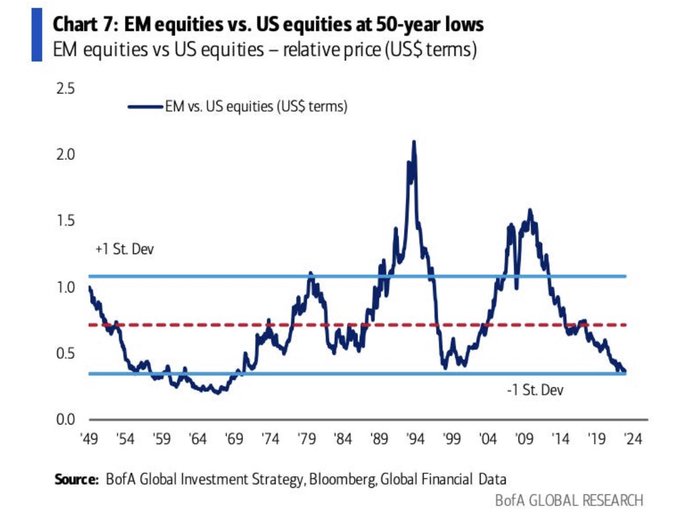A fascinating chart from Bank of America Global Research compares the performance of emerging markets equities against US equities. This chart shows the ratio of emerging markets to US equities, ranging from 0.3 on the low end to 2.1 on the high end. It provides a broad view of how these two markets have interacted over the last 75 years, revealing long-term cyclical trends.

Historical Trends in Emerging Markets
In the 1970s and 1980s, emerging markets performed exceptionally well. This was a time when the US was facing economic challenges, such as the Vietnam War. However, the trend shifted in the mid-1980s. From 1985 to 1993, US equities regained strength, but this period ended with the Asian financial crisis, which heavily impacted emerging markets. These shifts highlight the cyclical nature of the relationship between emerging markets and developed markets like the US.
The Early 2000s Boom
The last significant bull run for emerging markets began around 2002-2003. During this time, countries like India experienced tremendous growth, with markets booming until 2008. However, the global financial crisis brought this growth to a halt. Since then, recovery in emerging markets has been uneven, particularly with markets like China facing challenges. Despite this, the relative impact of India’s market on the overall emerging market index has remained minimal.
Current Market Dynamics
Today, the ratio of emerging markets to US equities is at a historical low. This suggests that emerging markets may be undervalued compared to US equities. As a result, there is a significant possibility that emerging markets could start to outperform US equities in the coming years. If this trend materializes, it could lead to a substantial inflow of funds into emerging markets.
Potential Shifts in Investment Allocations
Investment funds, especially large global funds, often have specific allocations for emerging markets. For instance, a $100 billion global fund might currently invest $80 billion in US stocks and $20 billion in emerging markets. If the fund manager decides to increase the allocation to emerging markets from $20 billion to $40 billion, it could result in a significant boost for these markets. India, as part of the emerging markets, would naturally receive a portion of this increased investment.
Looking Ahead
The perception and valuation of emerging markets compared to US equities are likely to shift. While these changes won’t happen overnight, the potential for a new upward cycle for emerging markets is strong. This could resemble the period from 2003 to 2008 when emerging markets, including India, saw substantial growth. Investors should keep an eye on these trends, as the next few years could mark the beginning of a new era of outperformance for emerging markets.

Disclaimers and disclosures : https://tinyurl.com/2763eyaz
If you have any questions, please write to support@weekendinvesting.com











